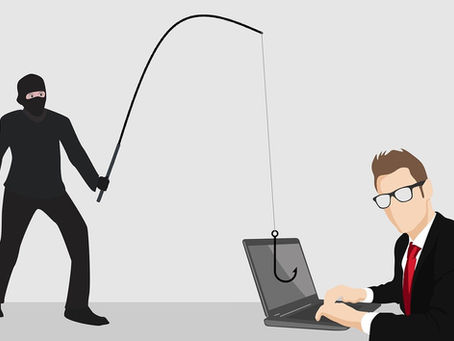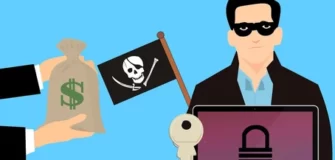What is Phishing?
Share

PHISHING
IMAGE COURTESY PIXABAY.COM
Background
In today’s digital age, with the ever-increasing reliance on technology, the internet has become an integral part of our daily lives. While it brings us convenience and countless opportunities, it also exposes us to various cyber threats. One of the most prevalent and deceptive threats is “Phishing.” We examine the details of phishing, its typical tactics, and essential strategies to shield ourselves from falling prey to this form of cyberattack.
Defining Phishing
Phishing is a sophisticated cybercrime technique employed by hackers and scammers to trick individuals into divulging sensitive information, such as usernames, passwords, credit card details, and personal data. These cyber adversaries create fraudulent communications, often disguised as genuine emails, messages, or websites, with the intention of deceiving unsuspecting users.
Note that if a person takes pains to verify the origin and genuineness of emails/WhatsApp messages/Web Forms then he/she can detect Phishing elements and prevent the attack from occurring.
The Anatomy of a Phishing Attack
Phishing attacks typically follow a well-designed script that encompasses multiple stages. Let us explore the typical anatomy of a phishing attack.
1. Create a bait– The first step is to create an alluring bait that entices the victim to take the desired action. This could be a tempting monetary offer, a fake urgency, or a notification claiming account compromise/freeze.
2. Establishing Credibility– Phishers go to great lengths to appear trustworthy, often impersonating reputable companies or individuals. They may replicate official logos, email addresses, and other elements to create a convincing image. Phishers may have access to some of your personal details already and use them to create trust and credibility. This is a favorite and unfortunately extremely effective tactic employed by phishers.
3. Eliciting an Immediate/Urgent Response -To increase the chances of success, phishers employ fear tactics or a sense of urgency, compelling victims to act hastily without thinking logically. You are advised not to hurry and take adequate time for due diligence.
4. Extracting Sensitive Information – The core objective of a phishing attack is to extract confidential data. This is usually achieved through fake login pages or malicious forms, where victims unwittingly divulge their personal information. You are advised to take enough time to find out whether the page/form is genuine. Only if satisfied proceed else report the incident to the concerned person/organization.
5. Unleash Attacks – Once the attackers obtain the desired information, they can perpetrate various cybercrimes, including identity theft, financial fraud, and even launching subsequent phishing attacks.
Popular Phishing Techniques
Phishers continuously innovate and adapt their tactics, making it essential for users to be aware of the various methods used to deceive them. Some prevalent phishing techniques include.
1. Spear Phishing – This targeted approach tailors the attack to a specific individual or organization. Attackers collect information about their victims from various sources to personalize the message, making it appear almost genuine.
2. Whaling – Whaling focuses on high-profile targets, such as executives or high-ranking officials, aiming to land a big catch with potentially valuable information.
3. Vishing – In vishing attacks, scammers use voice communication, typically over the phone, to extract sensitive data from unsuspecting victims.
4. Smishing – Phishers use SMS or text messages to deceive recipients into clicking malicious links or providing confidential information.
How to Effectively Protect Yourself from Phishing Attacks
While phishing attacks can be sophisticated, there are several proactive measures you can take to safeguard yourself and your sensitive information
1. Verify the Source-Always be cautious with emails, especially those requesting personal or financial data. Verify the sender’s email address and double-check for any unusual or suspicious content. There may be fraud email addresses resembling genuine email addresses. Visit the website or call up the customer care to find out whether it is a legitimate email address before taking any action.
2. Think Before You Click – Refrain from clicking on unexpected links or attachments, even if the email seems genuine. Instead, visit the official website directly through your browser.
3. Enable Two-Factor Authentication (2FA) – 2FA adds an extra layer of security to your accounts, requiring an additional verification step, such as a one-time code sent to your phone. Other options include personal data known by a very few such as your nickname, hometown, or date-of-birth.
4. Stay Informed and Aware -Keep yourself updated about the latest phishing tactics and cybersecurity trends. Awareness is key to recognizing potential threats and staying one step ahead of phishers. A tip is to visit the website of anti-virus companies which give out information about the latest and/or most threatening phishing techniques. Also daily read up on the latest phishing scams.
5. Educate Others – In most situations you are not working alone. At home, your family may have access to your computer. Children may unwittingly click on malicious links. At office your colleagues may inadvertently forward malicious emails. Share your knowledge with family, friends, and colleagues, promoting a culture of cyber vigilance and responsible online behavior.
Final Note
Phishing remains a major cyber threat that preys on unsuspecting individuals and organizations worldwide. By understanding the tactics deployed by phishers and adopting preventive measures, we can shield ourselves from becoming victims. Remember to stay vigilant, think twice before sharing sensitive information, and never underestimate the value of cyber awareness. With a collective effort to combat phishing, one can create a safer and more secure digital environment for everyone.


